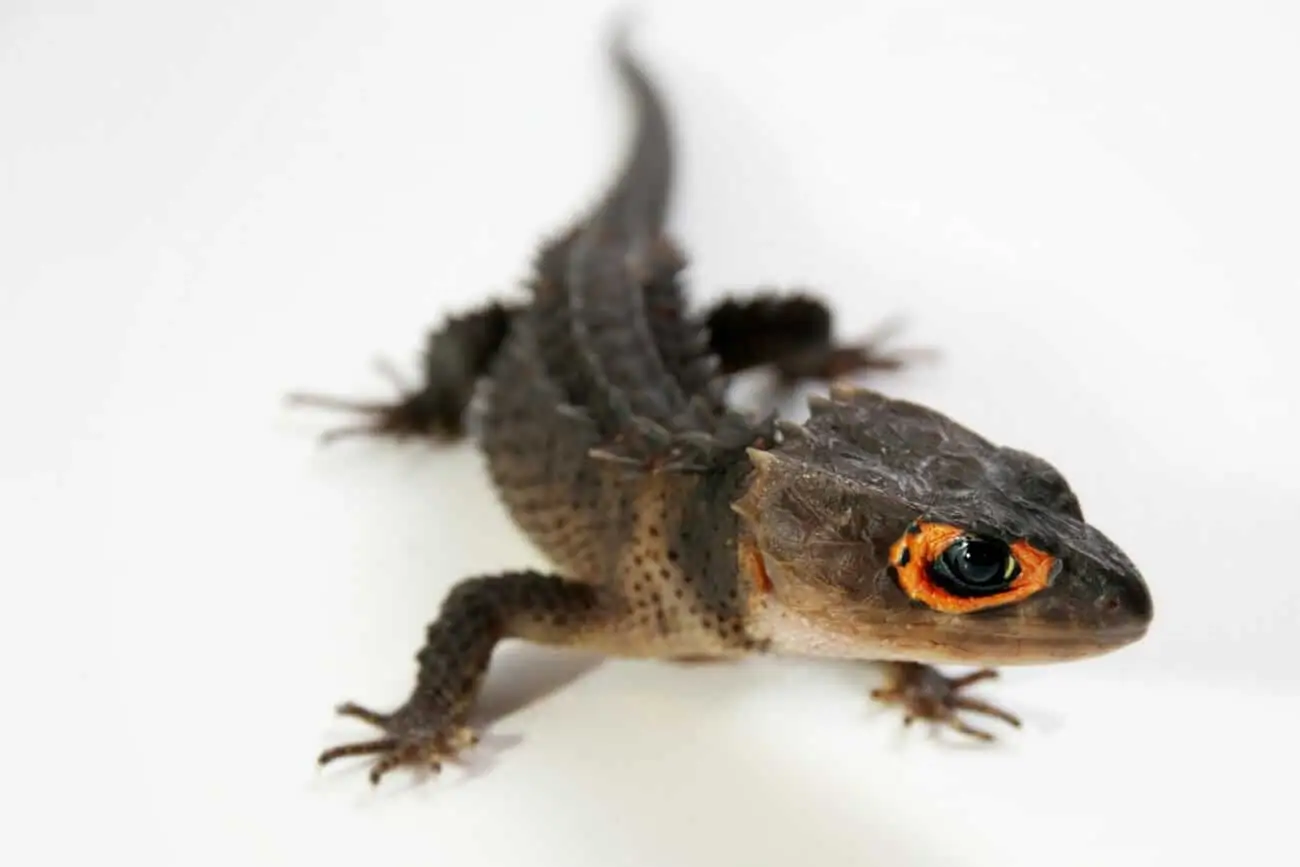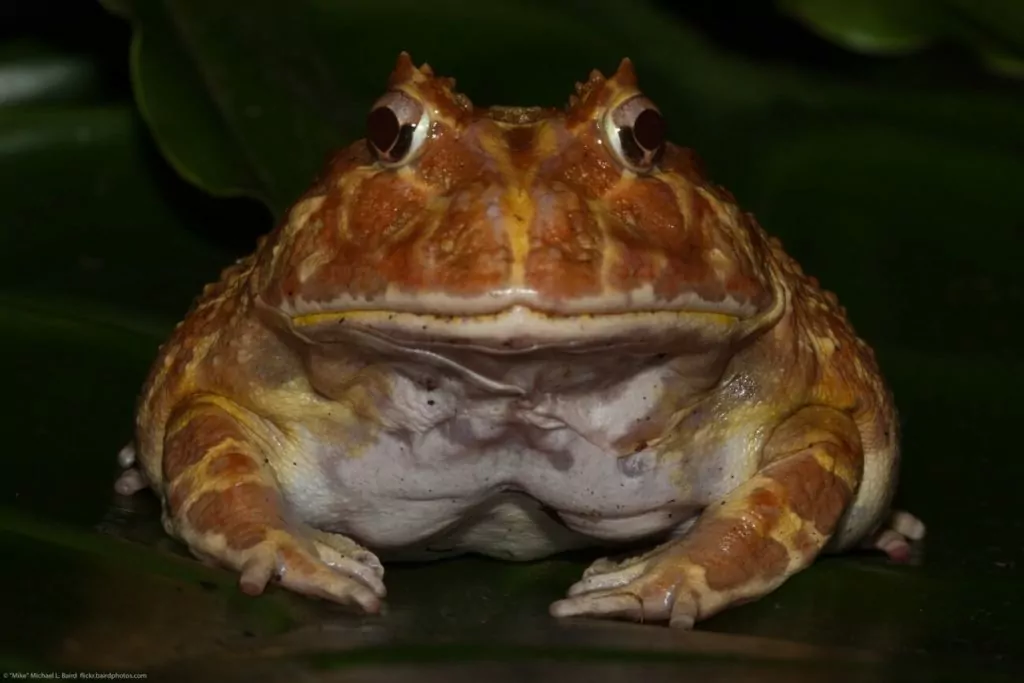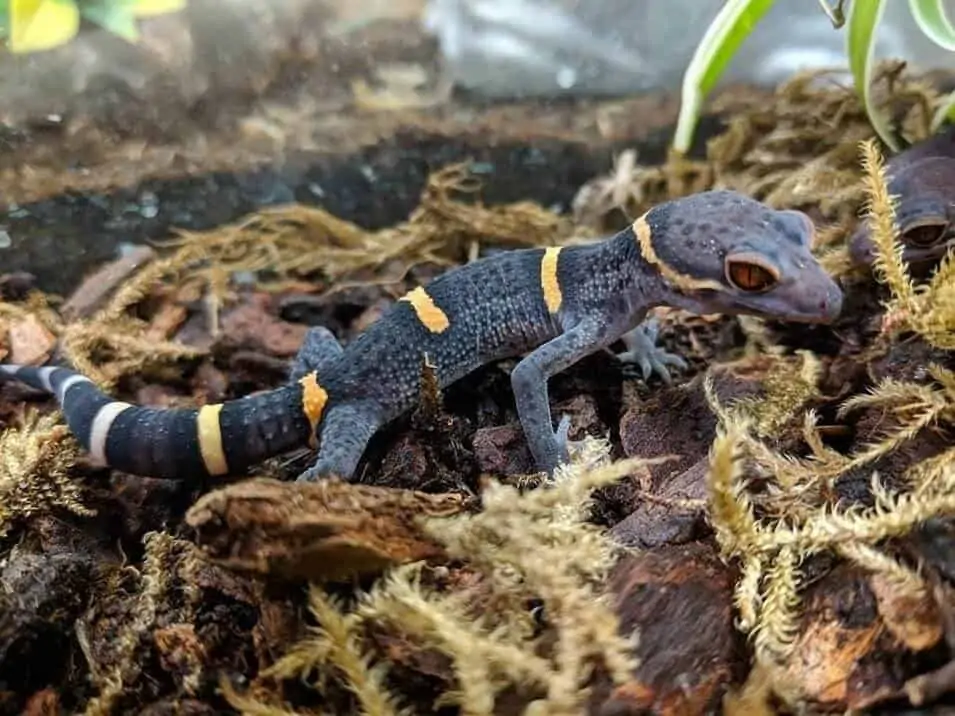Red-eyed crocodile skinks are one of our all-time favorite pet reptiles. This incredible lizard has a unique look that you can’t find anywhere else!
Because of their fascinating appearance, there’s been a lot of interest in this species over the past few years. Everyone seems to want one for themselves.
Since they’re so new to the scene, there are actually plenty of gaps when it comes to facts about established care requirements. But there are some fundamentals you should know that will help these reptiles thrive.
This detailed guide breaks down everything there is to know about red-eyed crocodile skink care. You’ll learn about their tank setup, diet, lifespan, size, and much more!
Table of Contents
Species Summary
The red-eyed crocodile skink (Tribolonotus gracilis) is a gorgeous reptile species. They look like a creature straight out of a fantasy novel! While they might look like dragons or dinosaurs, these reptiles are actually quite docile and shy.
They are endemic to New Guinea and part of Indonesia. Usually, they’re found hiding beneath leaves or scurrying around the floor of a rainforest.
This species is still relatively new to the reptile trade. Early specimens were imported back in the mid-1990s. Even today, they’re still considered to be very exotic.
Despite their timid nature, red-eyed crocodile skinks are a joy to raise and care for. They’re beautiful to watch and offer a touch of aesthetic wonder to any terrarium.
Appearance & Colors
There’s no denying that the red-eyed crocodile skink is one of the most interesting-looking and best pet lizards out there. They have a few unique physical traits, with the first being the head!
This species is casque-headed. They’re sporting a triangular-shaped head with a noticeable spiky ridge towards the back. It looks as if they’re wearing a helmet!
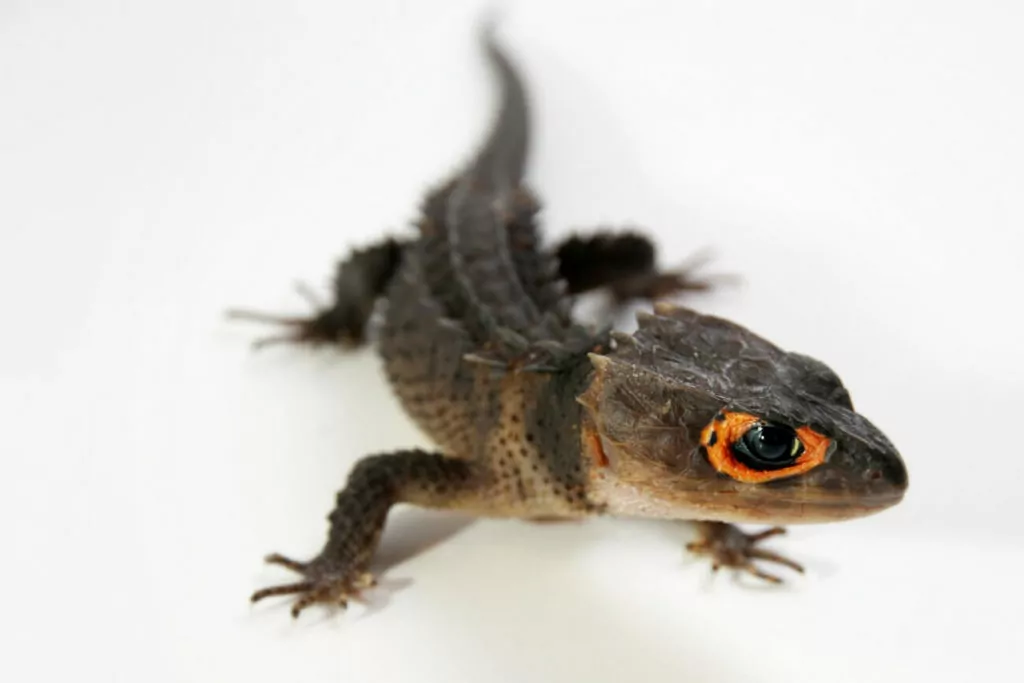
Running the length of the lizard, you’ll find four rows of keeled scales. The scales create a spiky look. Each spike curves backward, giving them that crocodilian or dragon-like appearance.
Overall, the body of the red-eyed crocodile skink is stout and heavy. This isn’t a slender lizard! They have strong bodies with equally strong legs.
The color of the reptile is relatively muted. Most of the body is covered in a deep brown color. The exception is the belly, which is a lighter tan. Around the eyes, the scales are vibrant reddish-orange.
Interestingly enough, juveniles don’t have those iconic eyes. Juveniles are usually lighter in color. They have a thick band of tan that runs along the back. It pairs nicely with the tan-colored head.
Usually, juveniles will start to develop a deeper color around six months of age.
Expert Tip: Mature adults are sexually dimorphic, but the differences are subtle. Males will have a stockier build and large pores on the hind feet. Some may even have some orange scales around the umbilical scar.
Red-Eyed Crocodile Skink Lifespan
The average red-eyed crocodile skink lifespan is roughly 10 years when kept in captivity. Some lucky owners have reportedly seen their lizards live up to 14 years in captivity, but no official reports or studies can confirm this.
It’s thought that the red-eyed crocodile skink lives much longer in captivity than in the wild. From what scientists know so far, the average lifespan in the wild is a mere six years.
Expert Tip: Because this reptile is still quite new to the trade, information is still sparse. But one thing enthusiasts can agree on is that quality of life has an impact on their life expectancy. Poor husbandry and care can lead to bad health, disease, and early death.
Average Size
The typical red-eyed crocodile skink size is about seven to nine inches when fully-grown. Some may reach lengths of 10 inches, but those instances are rare.
Since these reptiles don’t get very big, they are convenient pets when it comes to their required enclosure size. We’ll cover that in more detail further down in the guide.
Red-Eyed Crocodile Skink Care
Red-eyed crocodile skink care is not an exact science. While they’re highly sought after in the reptile trade, these lizards are still very exotic.
Enthusiasts are still learning new things about what this species needs and prefers. Luckily, there are some established care guidelines you can follow to provide the best life possible.
Expert Tip: As the community learns more about red-eyed crocodile skink care we’ll make sure to update this care sheet to reflect the latest recommendations.
Enclosure Size
It’s important to remember that floor space is more important for red-eyed crocodile skinks than climbing height. They will climb branches every once in a while, but most are going to spend their time on the floor of their habitat.
The best enclosure is going to be a traditional terrarium with front-facing doors and vents. Traditional glass aquariums work, too. However, it needs a screen top for proper ventilation.
When it comes to size, we recommend getting a tank that’s at least 30 inches long and 12 inches deep. That will be enough to keep a single skink or a male and female pair.
You can accommodate more if you want, but you’ll need a much larger enclosure to avoid territorial issues.
Habitat Setup
A natural habitat modeled after the wet rainforest floor is best. Red-eyed crocodile skinks are used to living on moist substrates.
You can use something as simple as newspapers or reptile carpet for the substrate. However, a commercial mix of coconut fiber, loam soil, and sphagnum moss may be better for creating a natural setup. You can even place some dried oak leaves on top for a more natural effect!
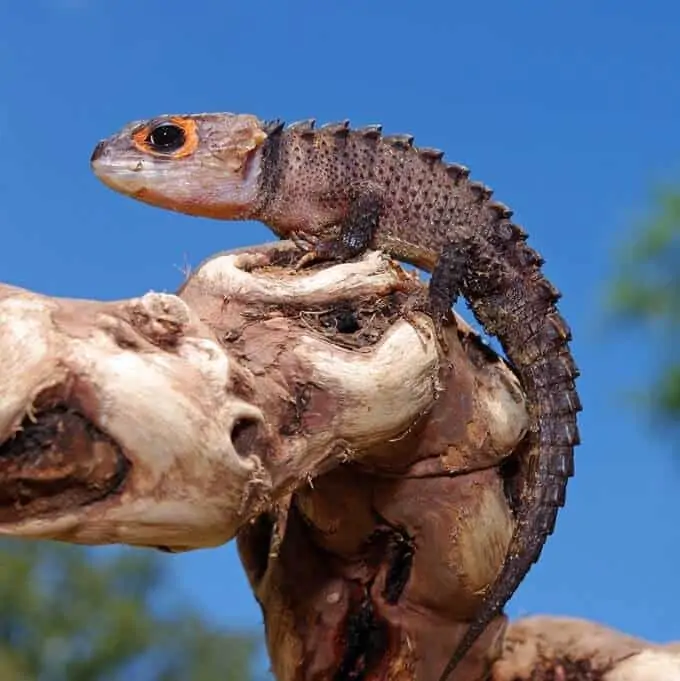
Some small climbing branches and basking rocks are always welcome. You can also implement real or artificial plants, which will act as shelter and provide a comfortable hiding spot.
Real plants like bromeliads and orchids work well. However, you will need to adjust your substrate to support the plants. To keep things simple, you can just use plastic or silk varieties of the same plants.
Another important thing to include in their habitat setup is some hides. Small cork logs, rocks caves, or even wooden boxes work well. These will give them a place to feel safe and comfortable (which is essential for this species).
Temperature & Lighting
Red-eyed crocodile skinks prefer moderate temperatures and a slight temperature gradient is the best way to accomplish this. The lizard might not use the basking light much, but it’s still an invaluable accessory that can help it regulate body temperature.
Place the basking lamp on one end of the enclosure so that it raises temperatures to about 80 to 82 degrees Fahrenheit.
For the cooler side of the enclosure, temperatures should be somewhere between 75 and 78 degrees.
Expert Tip: These lizards can tolerate temperatures as low as 73 degrees at night. If ambient temperatures dip below that, you’ll need to get a heat emitter or under-tank heating mat.
Red-eyed crocodile skinks are crepuscular, which means they’re most active at dawn and dusk. A UVB lamp may not be necessary, but it doesn’t hurt to have one. Use a low-powered 5-percent UV lamp.
Humidity
High humidity levels are a must for these lizards. The humidity should be between 70 and 90 percent in their enclosure at all times.
Use a hygrometer to check these levels regularly. You can easily raise the humidity by misting the substrate and plants. Use the vent on your terrarium to make fine adjustments to the airflow as well.
Water
It’s important to have a small water dish in the terrarium as well. Red-eyed crocodile skinks may not use it to drink out of, but they’ll use it to soak, hide, and cool off.
These lizards can hold their breath underwater for a long time while swimming, so don’t be surprised if you see them submerged.
Expert Tip: Make sure you clean out and replenish the dish regularly so that they always have access to clean water. Allowing dirty water to sit will lead to the growth of bacteria and potential health concerns for your reptile.
Food & Diet
Red-eyed crocodile skinks are insectivores through and through! In the wild, they scour the forest floor to dig up bugs. They’re not fans of plant-based foods, so you’ll want to stick to an all-insect diet.
You can provide foods like Dubia roaches, silkworms, crickets, mealworms, and red wiggler worms. They may accept a small pinky mouse from time to time, but that should only be reserved for large adults (it’s not necessary either).
Make sure that all of the insects are gut-loaded prior to feeding. You should also dust them with calcium powder every other meal.
Juveniles need to be fed every day to support their growth. Once the lizard reaches adulthood, you can scale back to feeding them every other day.
Potential Health Issues
Not a lot of information is known about potential diseases when it comes to these reptiles. In fact, it’s one of the less-understood elements of red-eyed crocodile skink care.
Because of this, you need to be extra-vigilant about keeping their environment as clean and disease-free as possible.
New imports should undergo fecal testing to ensure that they don’t have parasites. Once they’re in your home, spot clean the enclosure daily. About once a month, sanitize the entire habitat (this will keep bacteria and parasites at bay).
Red-eyed crocodile skinks can also suffer from common ailments like metabolic bone disease and respiratory infections. The former disease is a result of inadequate calcium. You can decrease the risks of the disease by providing UV light and calcium supplements.
Respiratory infections typically occur when temperature and humidity levels are outside of the acceptable range. Stay on top of habitat conditions and you should not experience these issues.
Behavior & Temperament
Red-eyed crocodile skinks are notoriously shy and timid. The reptiles will get more comfortable with their environment with time. But until then, don’t expect to see much of them!
They will spend most of their time hiding. Even once they get comfortable, these lizards rest for most of the day. They are more active in the late evenings and early mornings (which is also the best time to feed them).
Some aggressive behaviors can occur if you’re keeping more than one red-eyed crocodile skink in the same habitat. Males, in particular, are known to get very territorial. They may fight a bit if the habitat is too small.
Expert Tip: To avoid trouble, it’s best to keep males separate. You can house a male and female together. One male and two or three females are fine, too.
Handling Them
While you may be tempted to hold your red-eyed crocodile skink, it’s best to refrain from doing so. These lizards do not like being handled.
Red-eyed crocodile skinks are very vocal when distressed. If you lift them for more than a few minutes, they will start squealing and wriggling to get free. If you don’t let them go, they may even try to bite you!
This is a species that’s best observed through the glass of a terrarium rather than in your hand. Limit handling to when you need to clean the tank. Beyond that, just enjoy them in the habitat you created.
Wrapping Up
Even though there’s still a lot the reptile community doesn’t know about red-eyed crocodile skink care, you can still provide these lizards with a great life. All you need to do is follow the fundamentals and be attentive!
We hope this care sheet has given you a great base of knowledge if you’re thinking about getting these creatures as a pet. We tried to include all kinds of facts to make caring for them a piece of cake.
As time goes on, more information about their ideal care requirements will undoubtedly be discovered. When they do, we’ll make sure to update this guide to reflect the new info!
If you have any helpful tips, facts, or pictures that you think would be helpful to add to this guide, don’t hesitate to get in touch. We’re always looking for ways to improve the guides we publish.

